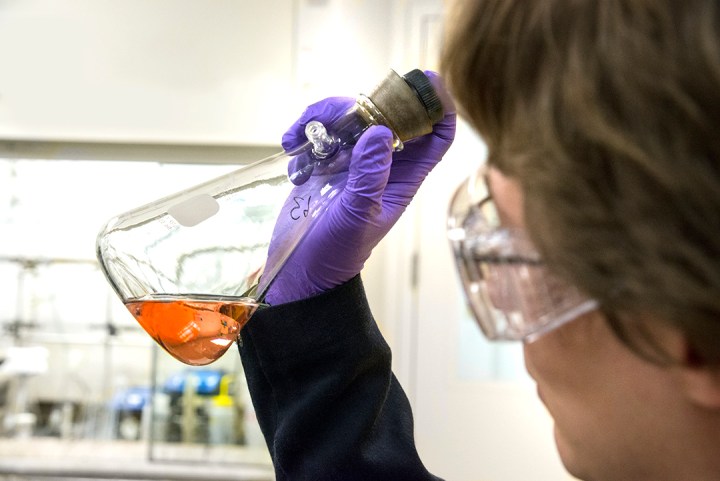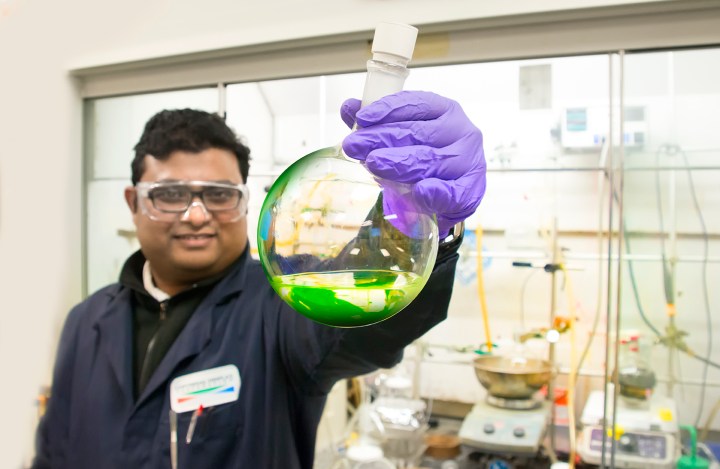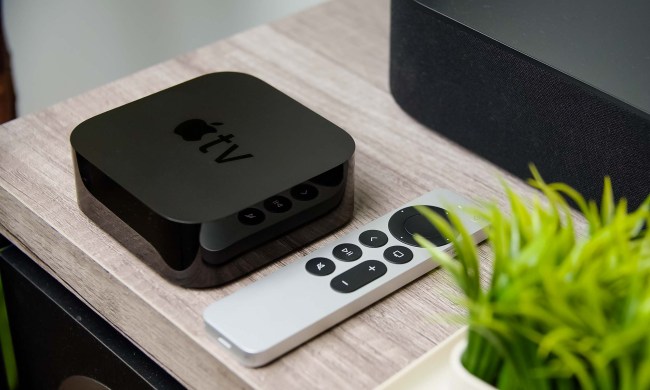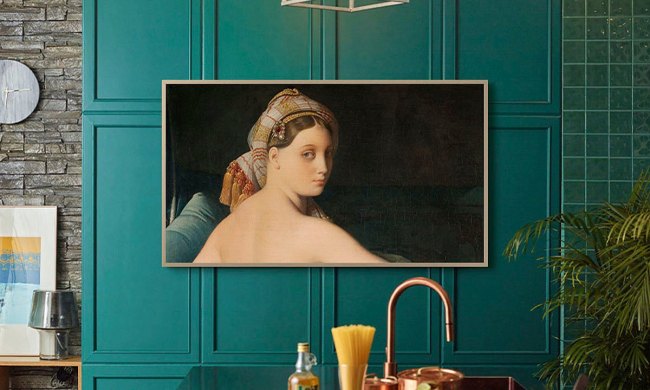The TV industry loves its acronyms, and we’ve got one more you should know about: PHOLED, which stands for Phosphorescent OLED.
That sounds like it might be a new kind of OLED TV tech, but it’s actually an enhancement of how existing OLED panels are built — one that promises far better energy efficiency, and possibly better brightness too. Here’s what you need to know.
More light, less heat

OLED technology — that’s Organic Light-Emitting Diode — uses individually-lit pixels, giving OLED TVs their distinctive perfect blacks and gorgeous colors. Electricity passes through the OLED material in each pixel, causing the material to emit photons (light) at different wavelengths.
What’s rarely discussed is that there are actually two kinds of OLED material. The first, and more common kind is fluorescent OLED material. Currently, all OLED and QD-OLED TVs are built using fluorescent OLED material as their primary light source.
Energized fluorescent OLED material converts electricity into light, but it also creates heat — quite a lot of it. For every unit of energy you pump into fluorescent OLED, the material emits 25% light and 75% heat.
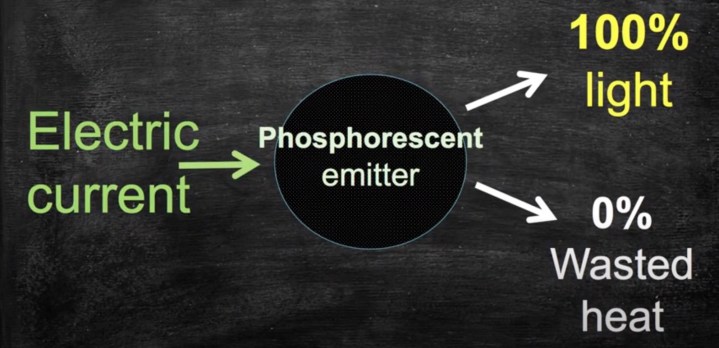
The second, less common type of OLED is phosphorescent OLED. When phosphorescent OLED material (PHOLED) is energized, that light-to-heat ratio becomes far more efficient at creating light — nearly 100% light and zero heat.
Red, green … and blue?
- 1. A UDC chemist examines red PHOLED material.
- 2. A UDC chemist examines green PHOLED material.
If PHOLED is clearly better at converting energy into light, why are companies like LG and Samsung still using inferior fluorescent OLED material? It turns out that it’s not so easy to chemically synthesize PHOLED material in such a way that it retains the other properties needed when using OLED in a TV.
It’s not enough for a PHOLED pixel to emit light at a nearly 100% level of efficiency — it also needs to produce a very specific range of wavelengths and it needs to last for thousands of hours. No one is going to buy a TV that loses half of its brightness after just a few hundred hours of use.
While the ability to create stable and accurate red PHOLED happened in 2003, and green PHOLED in 2013, the goal of an equally high-performance blue PHOLED has remained out of reach. That presents a big hurdle for the TV world.
At the moment, red and green OLED materials are predominantly used in mobile phone-, tablet-, and laptop-sized displays. They very rarely show up in TV-sized panels (this very expensive, 24-inch Sony broadcast mastering monitor being among the exceptions). Blue OLED, on the other hand, is a foundational ingredient in both LG Display’s WOLED and Samsung Display’s QD-OLED panels.
In LG’s panels, blue OLED is mixed with yellow-green OLED to create full-spectrum white light (which is then processed by a color filter). Samsung’s QD-OLED uses blue OLED as its exclusive source of light for each pixel and then converts some of the blue light into red and green light using quantum dots.
Who’s blue?
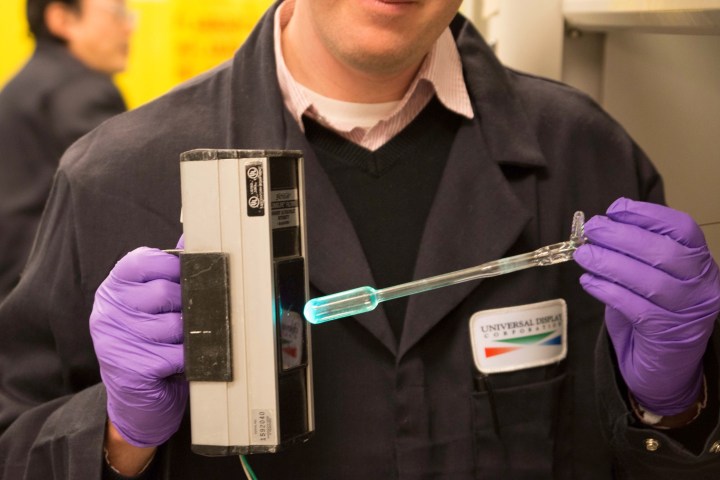
The reason we’re now talking about PHOLED as the next evolution of OLED TV tech is that Universal Display Corporation (UDC) — a global leader in the development and manufacture of OLED material — claims it has finally produced blue PHOLED material that is able to withstand the demands of constant and long-term use in a home TV and is currently readying it for mass manufacturing.
LG Display and Samsung Display — the only manufacturers producing OLED TV panels at scale — have yet to announce any plans to use UDC’s blue PHOLED material, but there have been several reports suggesting that both companies are actively investigating the possibility.
How is a PHOLED TV different from an OLED TV?

When PHOLED-based TVs eventually become available, it’s possible that the biggest difference will be felt in our electricity bills. If a PHOLED panel is truly 300% more energy efficient than today’s OLED panels (assuming a similar level of brightness), that means PHOLED TVs will use 75% less electricity to produce light. The OLED panel isn’t the only component of a TV that uses energy — processors, Wi-Fi, and speakers all use it too — but the panel itself is easily the biggest electricity consumer.
That kind of reduction of energy might not impact your wallet significantly (or maybe you watch a LOT of TV and it will?) but the knock-on effect of such a big efficiency gain could be huge for the carbon footprint of TVs on a global basis.
Curiously, the benefits of PHOLED may not be evenly distributed among OLED TVs. Because LG’s WOLED panels mix blue fluorescent OLED and yellow-green phosphorescent OLED materials, only the blue portion would see any change. Samsung’s QD-OLED panels only use blue fluorescent OLED, giving them a theoretically greater energy efficiency advantage after being upgraded to blue PHOLED.
UDC has suggested that PHOLED’s greater efficiency could also be translated into higher brightness. The company hasn’t offered any specific measurements, but given that one of today’s brightest OLED TVs — the Samsung S95C — can create 1,600 to 2,000 nits of peak brightness, even a modest 25% increase would yield 2,000 to 2,500 nits. That’s bright enough to nearly erase QLED’s brightness advantage over OLED in brightly lit rooms.
Does PHOLED offer any other advantages?

Even if PHOLED technology is only used to reduce energy consumption, the fact that it converts electricity into light, without any waste heat, could mean a longer lifespan for an OLED TV. Heat is like kryptonite to most electronics, so any reduction in heat is a good thing.
OLED material has the propensity to suffer burn-in under extreme viewing conditions. Burn-in (the appearance of shadows and other image artifacts) is the result of the uneven aging of OLED pixels. It’s rare, but it can happen.
Though UDC hasn’t made any claims regarding burn-in, we believe there’s a strong chance that PHOLED TVs will be more resistant to the problem. Passing an electrical current through OLED material causes it to age. The higher the voltage, the brighter it gets, but the more heat it generates (recall that fluorescent OLED outputs three units of heat for every one unit of light) — and that will shorten its lifespan.
If PHOLED can achieve similar levels of brightness with less energy (and no heat), the material should age at a slower rate.
When will I be able to buy a PHOLED TV?
UDC says it’s on track to start shipping its blue PHOLED material to its customers in 2024. If that timing proves accurate, we may see the first PHOLED-based TVs arrive as early as 2025.
Is PHOLED the end of the line for OLED TV development?
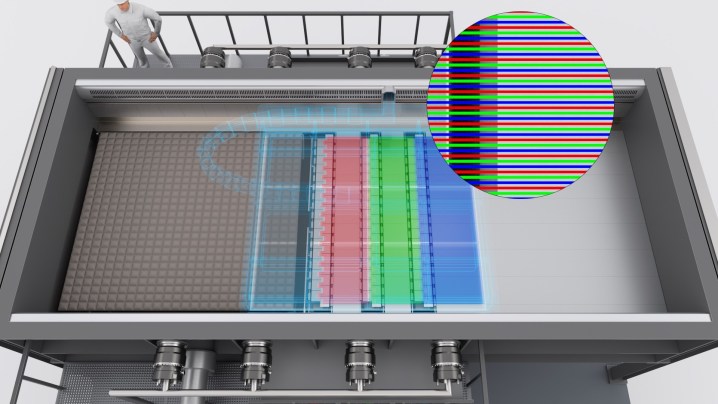
It looks as though PHOLED is going to be the leading OLED material for years to come, but UDC thinks it has another technology that could be just as transformative if it’s adopted by TV makers. Known as Organic Vapor Jet Printing (OJVP), it’s a new way of directly printing red, green, and blue PHOLED material onto TV-sized panels.
OLED panels created using OJVP would have the same RGB pixel composition as that high-end Sony OLED monitor, but with a much lower manufacturing cost. In theory, this could lead to the cheapest, highest-performance OLED TVs we’ve ever seen.
Don’t get too excited about it just yet — UDC is only in the early stages of prepping OJVP for commercialization and no manufacturers have announced an intention to use it.
Is PHOLED the best TV technology?
We should think of PHOLED as a small evolution of existing technology — one that supercharges OLED for better performance and efficiency, but it doesn’t fundamentally change the nature of OLED TVs.
In the not-so-distant future, we expect to see the emergence of QDEL (quantum dot electroluminescence) displays with light-emitting pixels made exclusively from red, green, and blue quantum dots — no OLED needed and thus no burn-in risk.
Another display technology that is already available and becoming more affordable each year is microLED, which uses tiny RGB LED subpixels that can get achingly bright, again with no burn-in.
